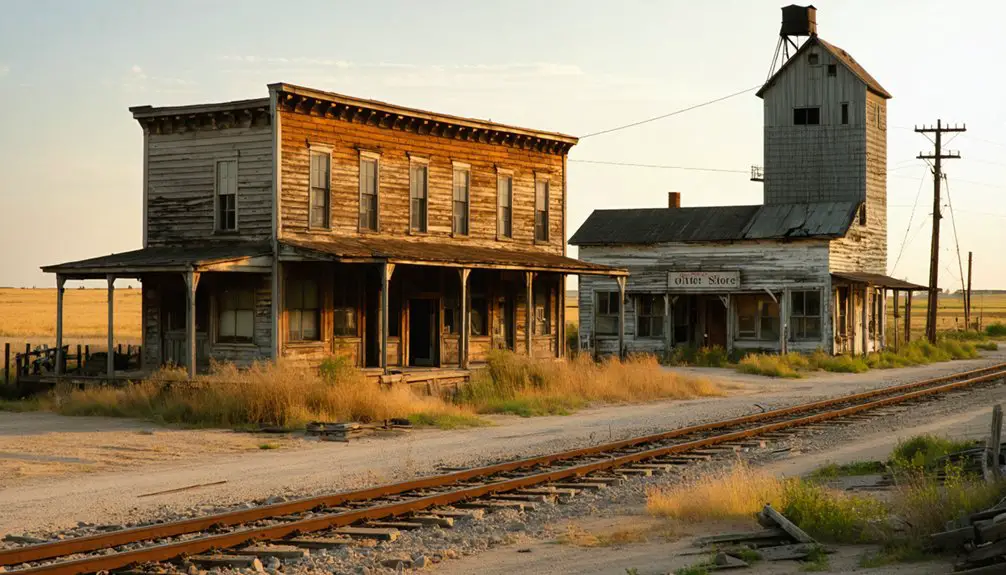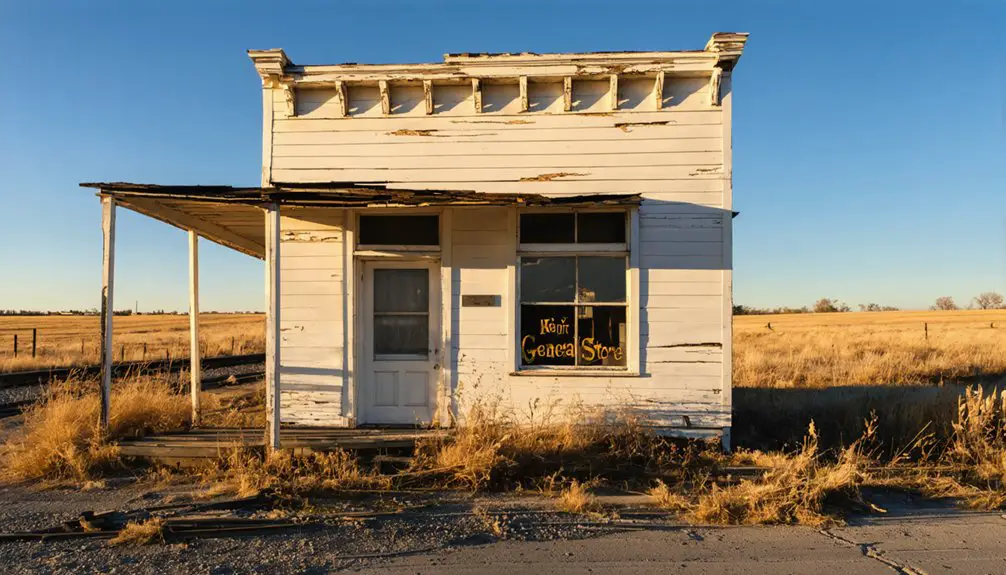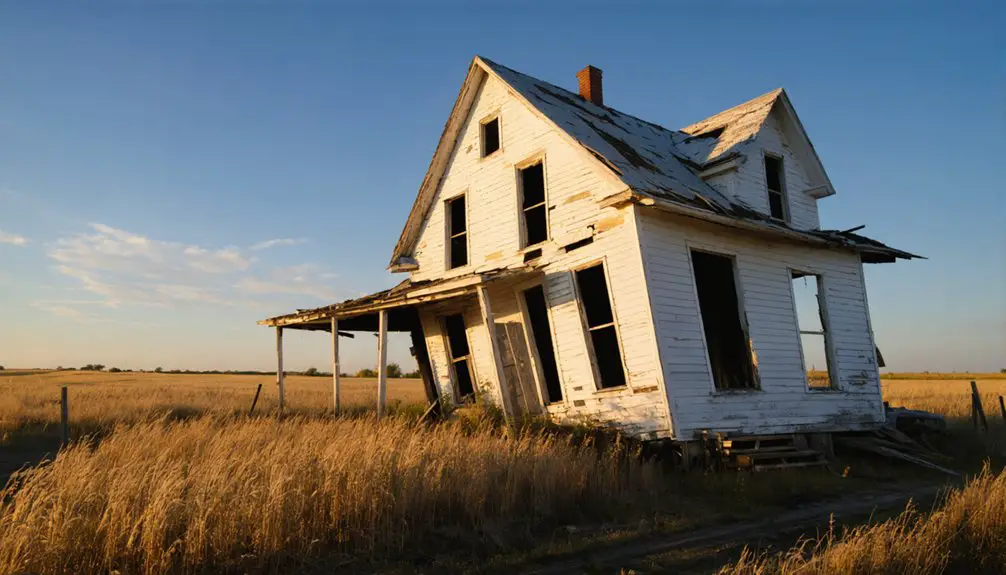You’ll find Hunnewell’s ghost town remains in Sumner County, Kansas, where Boston financier H.H. Hunnewell established a crucial cattle shipping hub in the 1880s. At its peak, this frontier boomtown shipped over 1,500 cattle loads annually and housed 233 residents, eight saloons, and a bustling commercial district. The town’s wild reputation included the infamous 1884 Hunnewell Gunfight, though its prosperity faded when railroad routes shifted south. The weathered buildings still whisper tales of cowboys, shootouts, and frontier justice.
Key Takeaways
- Hunnewell transformed from a bustling cattle shipping hub to a ghost town after railroad lines shifted south into Oklahoma and Texas.
- At its peak in 1890, Hunnewell had 233 residents, eight saloons, hotels, and stockyards before declining in the early 1900s.
- The town served as a strategic cattle shipping point with railway connections that made Kansas City stockyards accessible.
- Hunnewell was notorious for lawlessness and violence, exemplified by the 1884 Hunnewell Gunfight at Hanley’s Saloon.
- The town’s final decline was marked by the closure of the post office in 1960, leaving only scattered buildings as remnants.
The Birth of a Frontier Boomtown
While many frontier towns emerged during America’s westward expansion, Hunnewell, Kansas carved out its unique place in history as a strategic cattle shipping point near the Indian Territory border.
You’ll find its roots in the vision of Boston financier H.H. Hunnewell, who recognized the location’s potential along the Leavenworth, Lawrence, and Galveston Railroad line.
As cattle trails converged near the Oklahoma border, Hunnewell quickly transformed from prairie grassland into a bustling frontier life hub. With its notorious reputation, the town became known for its high levels of violence as cowboys and railroad workers frequently clashed.
By 1890, you’d have found a town of 168 residents, complete with hotels, stores, and saloons catering to cowboys and railroad workers.
The town’s strategic position made it an ideal shipping point, where thousands of cattle loads moved through annually, establishing Hunnewell as an essential link between the untamed territories and eastern markets. The town particularly thrived from cattle shipments after livestock were removed from the Cherokee Strip.
Rails and Cattle: Economic Foundations
As the Sumner County Railway Company laid tracks southward from Wellington in 1880, Hunnewell emerged as an essential hub in the region’s expanding rail network.
You’d have witnessed intense railroad competition that drove cattle shipping rates down from $40 to just $10 per carload, making it easier for Texas longhorns to reach northern markets.
During its heyday, you could’ve found a bustling town with eight saloons, two dance halls, and significant infrastructure like telegraph offices and grain elevators. The Atchison, Topeka & Santa Fe ultimately gained control through strategic acquisitions and mergers.
Hunnewell thrived as a vibrant frontier town, boasting lively saloons, dance halls and modern amenities serving the booming railroad trade.
The Kansas City stockyards were now within reach, thanks to strategic rail connections. Multiple railroad companies fought to control these valuable routes through complex corporate deals and consolidations. By 1889, the town’s success was evident as over 1,500 loads of cattle were shipped from its rail yards.
Wild West Days and Lawless Nights
The economic prosperity of Hunnewell’s rail and cattle trade brought a darker side to town life.
You’d find no official law enforcement in this Kansas cowtown, where community regulations fell to the ranchers themselves. With eight or nine saloons, two dance halls, and several gambling houses, violence erupted frequently between cowboys and railroad workers.
Without notable lawmen like Bat Masterson to keep order, you’d witness shootouts and brawls that rivaled any wild west town. The lack of formal peacekeepers meant ranchers took justice into their own hands. This caused frequent link disambiguation issues when documenting the town’s various violent incidents. In 1884, a deadly romantic rivalry shootout between drovers and lawmen highlighted the town’s violent nature.
During the 1893 Cherokee Outlet land rush, the town’s lawless reputation intensified as thousands flooded in, filling the saloons and gambling houses. These wild days defined Hunnewell’s character until changing railroad routes gradually emptied the streets.
The Famous Hunnewell Gunfight
While enjoying drinks at Hanley’s Saloon on October 5, 1884, cowboys Oscar Halsell and Clem Barfoot’s rowdy behavior drew the attention of Deputy Sheriff Ed Scotten and Ham Raynor.
The conflict originated when a woman chose to leave Raynor for Halsell’s affections, intensifying tensions between the men.
You’d have witnessed the ensuing confrontation spill into a nearby alley, where Barfoot likely fired first in a deadly exchange that left himself dead, Scotten mortally wounded, and Raynor surviving despite five gunshot wounds.
Though Kansas’ governor posted a reward for the cowboys’ capture, Halsell later surrendered through his brother’s arrangement and was ultimately acquitted of Scotten’s murder, marking another chapter in Hunnewell’s violent frontier history.
Following the incident, Halsell went on to become a prosperous rancher in Oklahoma.
Prelude to Fatal Confrontation
During a tense evening on October 5, 1884, Hunnewell’s Hanley’s Saloon became the staging ground for what would become one of Kansas’ most notorious cowtown gunfights.
In this typical frontier establishment, you’d find the clash of two worlds as lawmen Ed Scotten and Ham Raynor confronted troublemaking cowboys Oscar Halsell and Clem Barfoot. Much like Newton’s Hide Park district, these saloons were hotbeds of violence and lawlessness.
The saloon conflicts that erupted that night reflected the volatile nature of cowboy culture in Kansas cowtowns.
- First came the loud disturbance inside, with Halsell and Barfoot’s rowdy behavior fueled by whiskey.
- Then the lawmen’s arrival, demanding order be restored.
- A heated argument erupted, tensions rising with each passing moment.
- Finally, the fateful move outside to the alley, where steel would soon meet flesh.
Shots Ring Out
As tensions boiled over in the alley behind Hanley’s Saloon, Oscar Halsell and Clem Barfoot squared off against lawmen Ed Scotten and Ham Raynor in what would become Hunnewell’s deadliest gunfight.
In true saloon culture fashion, the confrontation quickly escalated from harsh words to drawn weapons. You’d have witnessed gunfight tactics typical of the era as both sides sought cover in the dusty alley.
When the smoke cleared on that fateful October 5, 1884, Clem Barfoot lay dead, and Deputy Sheriff Ed Scotten had suffered mortal wounds. Halsell managed to escape in the chaos, though the governor would soon put a price on his head.
While he’d later be acquitted of murder charges, the violent episode cemented Hunnewell’s reputation as a dangerous Kansas cowtown.
Aftermath and Legal Impact
Despite public outrage over the deadly Hunnewell gunfight, legal proceedings against the participants never materialized into criminal convictions.
The community response highlighted serious weaknesses in frontier law enforcement, eventually forcing state-level intervention when local governance began to collapse.
The legal consequences of the incident revealed how Kansas’ justice system struggled with frontier violence, similar to how modern courts have established that the Protection of Lawful Commerce shields firearms manufacturers from liability in criminal misuse cases.
- The Kansas Governor received desperate petitions about the town’s deteriorating leadership
- Six council members faced threats of mandamus writs to perform their duties
- The Attorney General had to intervene to restore basic civic functions
- Mrs. Ella Wilson’s local agitation finally compelled state action
You can see how this pivotal event exposed deep flaws in frontier justice, though Oscar Halsell, a key figure in the conflict, later prospered as a successful rancher despite the turmoil.
Saloons and Social Life on the Border
You’ll find Hunnewell’s bustling frontier bar scene of the 1880s centered around eight to nine saloons, which served as primary gathering spots for cowboys, railroad workers, and locals along the Kansas-Oklahoma border.
These establishments, along with the town’s dance halls and hotel, fostered a rowdy atmosphere where alcohol flowed freely and gunfights weren’t uncommon.
The boisterous social life reflected the broader economic connections between cattle shipping and railroad commerce, with saloons acting as informal networking hubs for ranchers and workers until the town’s decline in the early 1900s.
Frontier Bar Culture
While frontier towns often sprang up around trading posts or railroad stops, saloons quickly became the beating heart of communities like Hunnewell.
The simple saloon architecture, with its long wooden bars and rustic furnishings, created spaces where frontier camaraderie flourished among cowboys, miners, and travelers alike.
You’d find these establishments serving multiple purposes in frontier life:
- A makeshift courthouse where local disputes were settled
- An informal bank where gold dust and bartered goods changed hands
- A community center hosting town meetings and social gatherings
- An essential information hub where news spread through storytelling and debate
These weren’t just drinking establishments – they were the foundation of frontier society, where newcomers could quickly plug into local networks and weather-worn regulars could find relief from the isolation of prairie life.
Rowdy Border Entertainment
The bustling border entertainment scene in Hunnewell exemplified the raw energy of Kansas frontier life, with up to 20 liquor-serving establishments packed into a single block.
You’d find everything from basic saloons to upscale cabarets featuring Count Basie and other jazz greats, all operating around the clock.
Border nightlife thrived on a mix of legal and illegal activities, with gambling rooms visible from the street and venues serving both alcohol and marijuana.
Saloon culture wasn’t without its dark side.
Characters like “Rowdy Joe” Lowe and Red Beard made these establishments notorious for violent confrontations.
The 1873 gun battle in nearby West Wichita showed just how dangerous these venues could become, though local courts often let troublemakers walk free, only to skip town afterward.
Peak Years of Growth and Prosperity

During its peak years from the 1880s through 1900, Hunnewell emerged as an essential cattle shipping hub where commerce and frontier life intersected.
In frontier America, Hunnewell transformed into a vital crossroads where cattle drives met the promise of eastern markets.
The town’s strategic location along key transportation routes made it a crucial link between Texas cattle drives and eastern markets.
You’d have found a bustling frontier economy driven by:
- Eight to nine saloons where cowboys and railroad workers spent their hard-earned wages
- A robust commercial district with two general stores, a hotel, and banking services
- Critical infrastructure including stockyards, telegraph offices, and a money order post office
- A population that swelled to 233 residents, mostly comprised of independent-minded cattle traders and railroad workers
The cattle trade flourished as two major railroads converged here, cementing Hunnewell’s position as a significant shipping point for Texas livestock heading to Kansas City stockyards.
Notable Characters and Colorful Residents
Among Hunnewell’s most notable figures, you’ll find Oscar Halsell, who transformed from a gunfight participant into a prosperous rancher known for employing outlaws like Bill Doolin and George “Bittercreek” Newcomb.
The town’s dangerous reputation was cemented by the infamous 1884 shootout at Hanley’s Saloon, where Deputy Sheriff Ed Scotten was mortally wounded and Clem Barfoot was killed.
You’ll discover that Hunnewell’s business community centered around its eight saloons, which drew a mix of railroad workers, cowboys, and merchants who shaped the town’s wild character.
Gunfighters and Lawmen
Violence and lawlessness defined life in Hunnewell during its cowtown era, as evidenced by the infamous 1884 gunfight at Hanley’s Saloon. The confrontation between lawmen Ed Scotten and Ham Raynor against cowboys Oscar Halsell and Clem Barfoot added to the town’s gunfighter legends.
You’ll find these compelling elements of lawman rivalries and frontier justice in Hunnewell’s story:
- Deputy Sheriff Ed Scotten died pursuing his duty, mortally wounded while attempting to restore order.
- Ham Raynor’s personal vendetta against Oscar Halsell fueled the conflict’s intensity.
- Clem Barfoot paid the ultimate price, killed during the heated exchange.
- Oscar Halsell survived to become a prosperous rancher, later employing notorious outlaws like Bill Doolin.
The lack of prosecution following this deadly encounter highlighted the challenges of maintaining law and order in Kansas cowtowns.
Cowboys Who Made History
Notable cowboys shaped Hunnewell’s wild character, with Oscar Halsell emerging as one of the town’s most fascinating figures. Halsell, who’d later become a prosperous rancher, wasn’t afraid to hire notorious outlaws like Bill Doolin and Bittercreek Newcomb to work his land.
You’ll find his name tied to the infamous 1884 gunfight at Hanley’s Saloon, where fellow cowboy Clem Barfoot lost his life.
The cowboy culture in Hunnewell centered around the bustling cattle trade, with ranching challenges forcing cowboys to create informal networks for protection. They’d move Texas cattle through the stockyards via the Leavenworth, Lawrence, and Galveston Railroad.
Through their dance halls, saloons, and everyday exploits, these colorful characters left an indelible mark on the town’s frontier identity.
Influential Local Merchants
While Hunnewell thrived as a bustling cattle town in the 1880s, two prominent general stores anchored its commercial district, supplying essential goods to the town’s mix of railroad workers, cowboys, and settlers.
You’ll find that merchant partnerships faced constant supply challenges in this rough-and-tumble environment.
Beyond the general stores, the town’s commercial spirit lived through:
- Eight saloons that dominated the social scene, including the infamous Hanley’s where the 1884 gunfight erupted
- A lone barber shop that kept cowboys and railmen looking presentable
- Two dance halls that brought moments of joy amid the frontier chaos
- A handful of small merchants who adapted to serve a population that peaked at 233 citizens
Today, these businesses stand only in memory, proof of Hunnewell’s wild frontier legacy.
Railroad Evolution and Economic Shifts
As railroads transformed the American frontier in the late 19th century, Hunnewell emerged as an essential shipping hub following its 1880 establishment by the Sumner County Railway Company.
You’d have seen intense railroad competition as multiple lines vied for the lucrative cattle trade, connecting the town to Wellington, Rome, and South Haven, while extending into Indian Territory.
During the 1880s, you could’ve witnessed Hunnewell’s prosperity as it served as a major shipping point for Texas cattle headed to Kansas City stockyards.
The town bustled with retail stores, a mill, elevator, and banking services.
However, as railroad consolidations reshaped the landscape and the cattle trade shifted elsewhere, economic decline set in.
The Slow Fade Into History

The decline of Hunnewell began quietly in the early 1900s, following its peak population of 233 residents at the turn of the century.
You can trace the town’s economic decline through several pivotal events that led to its community disintegration:
- The southward shift of major railroad lines into Oklahoma and Texas stripped away Hunnewell’s transportation advantage.
- The gradual closure of local businesses, from the historic Hunnewell House hotel to the town’s various saloons and shops.
- The diminishing cattle trade in Sumner County, which had been the backbone of local commerce.
- The final blow in 1960 when the post office closed its doors.
Today, you’ll find little remaining of this once-bustling cowtown except scattered buildings and occasional railroad activity, as Hunnewell rests quietly as another Kansas ghost town.
Legacy of a Kansas Cowtown
Founded in 1880, Hunnewell earned its place in Kansas history as an essential nexus of cattle shipping and railroad commerce.
You’ll find its impact carved into the story of the American frontier through its role in major cattle routes connecting Texas ranches to Kansas City stockyards.
At its height, you’d have witnessed a bustling cowtown where 1,500 cattle loads shipped annually, eight saloons thrived, and thousands gathered for the Cherokee Outlet opening.
When cattle trains thundered and saloons bustled, Hunnewell stood as a mighty gateway between Texas ranches and northern markets.
Despite its small population of 168, Hunnewell’s economic influence stretched from Texas to Kansas City, shaping regional commerce through its strategic railway connections.
While lawlessness and gunfights marked its wild days, the town’s eventual economic decline couldn’t erase its significance in transforming cattle shipping across the American West.
Frequently Asked Questions
Are There Any Remaining Original Buildings Still Standing in Hunnewell Today?
Despite 140+ years of history, you’ll find limited historical preservation today. While scattered old homes exist and grain elevators operate, there’s no confirmed architectural significance among any surviving original structures from the town’s peak.
What Native American Tribes Originally Inhabited the Area Before Hunnewell’s Founding?
You’ll find the DHEGILHA Siouan tribes, including the Osage, Quapaw, Omaha, Ponca, and Kansa, held historical significance in your area’s native lands before European settlement forced their relocation.
Did Any Famous Outlaws Besides Oscar Halsell’s Associates Pass Through Hunnewell?
Among 200+ recorded outlaws in 1880s Kansas, you’ll find no definitive records of other famous outlaws visiting Hunnewell beyond Halsell’s known associates like Bill Doolin and George “Bittercreek” Newcomb.
How Did Local Women Influence the Development of Early Hunnewell?
You’ll find women’s roles were transformative, especially through Ella Wilson’s groundbreaking mayoral leadership in 1911 and other women’s extensive community leadership in education, business, and social services throughout Hunnewell’s early development.
What Was the Average Cost of Land in Hunnewell During Its Peak?
While you’d likely pay premium rates near the railroad, exact average land prices aren’t documented, though a notable 93-acre purchase by George W. Miller in 1885 suggests organized real estate transactions during peak years.
References
- https://www.legendsofamerica.com/hunnewell-gunfight/
- https://en.wikipedia.org/wiki/Hunnewell
- https://www.legendsofamerica.com/hunnewell-kansas/
- https://theactiveage.com/these-kansas-towns-didnt-stand-a-ghost-of-chance/
- https://www.youtube.com/watch?v=OyBXD18P_j4
- https://www.kancoll.org/khq/1959/59_1_lough.htm
- https://legendsofkansas.com/sumner-county-kansas/
- https://www.kspatriot.org/index.php/articles/16-territorial-kansas/624-kansas-and-the-indian-frontier.html
- https://legendsofkansas.com/southern-kansas-western-railroad/
- https://kids.kiddle.co/Hunnewell



